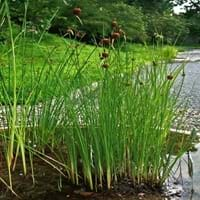Life Span
Annual
Perennial
Type
Flowering Plants
Aquatics
Origin
Mexico, Central America, South America
Eastern Europe, Western Asia
Types
Not available
Common Cattail, Southern Cattail, Dwarf Bulrush
Habitat
Cultivated Beds
Lake margins, Ponds, Swamps
USDA Hardiness Zone
8-11
3-11
AHS Heat Zone
12 - 1
12-1
Sunset Zone
A1, A2, A3, H1, H2, 1a, 1b, 2a, 2b, 3a, 3b, 4, 5, 6, 7, 8, 9, 10, 11, 12, 13, 14, 15, 16, 17, 18, 19, 20, 21, 22, 23, 24
21,22
Habit
Cushion/Mound-forming
Upright/Erect
Flower Color
Yellow, Orange, Gold, Orange Red
Yellow, Green, Brown, Chocolate
Flower Color Modifier
Bicolor
Not Available
Fruit Color
Not Available
Light brown, Light Red
Leaf Color in Spring
Green
Green, Dark Green
Leaf Color in Summer
Green
Green, Dark Green
Leaf Color in Fall
Green
Green, Dark Green
Leaf Color in Winter
Light Green
Brown
Leaf Shape
Pinnate
Long linear and narrow
Plant Season
Spring, Summer, Fall
Summer, Fall, Winter
Sunlight
Full Sun, Partial Sun
Full Sun, Partial Sun
Type of Soil
Loam, Sand
Clay, Loam, Sand
The pH of Soil
Acidic, Neutral
Acidic, Neutral
Soil Drainage
Well drained
Poorly Drained
Bloom Time
Indeterminate
Summer, Late Summer, Early Fall
Tolerances
Drought
Wet Site
Where to Plant?
Ground
Container, In Water
How to Plant?
Divison, Layering, Stem Cutting
Runners
Plant Maintenance
Medium
Low
Watering Requirements
Requires regular watering
Plant grows in water
In Summer
Lots of watering
Aquatic Plant
In Spring
Moderate
Aquatic Plant
In Winter
Average Water
Aquatic Plant
Soil pH
Slightly Acidic
Acidic, Neutral
Soil Type
Sandy
Clay, Loam, Sand
Soil Drainage Capacity
Well drained
Poorly Drained
Sun Exposure
Part sun
Full Sun, Partial Sun
Pruning
Remove damaged leaves, Remove dead branches, Remove dead leaves
Prune in early spring, Remove damaged leaves, Remove dead branches, Remove dead leaves
Fertilizers
All-Purpose Liquid Fertilizer
Nitrogen, Phosphate
Pests and Diseases
Red blotch
Red blotch
Plant Tolerance
Drought
Drought
Flower Petal Number
Single
Single
Fragrant Bark/Stem
Yes
No
Foliage Texture
Fine
Medium
Foliage Sheen
Matte
Matte
Attracts
Butterflies
Birds, Flying insects
Allergy
Not Available
no allergic reactions
Aesthetic Uses
Beautification, Decorating walls, Hanging Basket, Showy Purposes, Used as an interior landscaping species
Beautification, Showy Purposes, Water gardening
Beauty Benefits
Not Available
Not Available
Environmental Uses
Air purification, Food for birds
Food for animals, Food for birds, Food for insects, Nesting sites for birds
Medicinal Uses
Cancer, Diarrhea, Hepatitis, Inflammation, Wounds
Nutrients
Part of Plant Used
Flowers
Leaves
Other Uses
Air freshner, Condiment, For making oil for cosmetics, Garland, Making Sweet Scented Oil, Medicinal oil, Used as an ointment, Used as Ornamental plant, Used for fragrance, Used for its medicinal properties, Used for Landscaping
Decoration Purposes, Showy Purposes, Used as Ornamental plant
Used As Indoor Plant
Insignificant
Yes
Used As Outdoor Plant
Yes
Yes
Garden Design
Dried Flower, Landscape, Lawns and Turf
Bog Garden, Container, Water Gardens
Botanical Name
Tagetes subulata
TYPHA minima
Common Name
Tagetes Sabulata
Dwarf Cattail
In Hindi
Tagetes subulata
बौना कैटेल
In German
Tagetes Subulata
Dwarf Rohrkolben
In French
Tagetes Subulata
Cattail nain
In Spanish
Tagetes Subulata
Espadaña enano
In Greek
Tagetes Subulata
Νάνος Cattail
In Portuguese
Tagetes Subulata
Tifa Dwarf
In Polish
Tagetes Subulata
Dwarf Ożypałka
In Latin
Tagetes Subulata
Pumilio Cattail
Phylum
Tracheophyta
Tracheophyta
Class
Magnoliopsida
Liliopsida
Family
Asteraceae
Typhaceae
Clade
Angiosperms, Asterids, Eudicots
Angiosperms, Commelinids, Monocots
Tribe
Tageteae
Not Available
Subfamily
Asteroideae
Not Available
Number of Species
Not Available
Not Available
Importance of Tagetes Subulata and Dwarf Cattail
Want to have the most appropriate plant for your garden? You might want to know the importance of Tagetes Subulata and Dwarf Cattail. Basically, these two plants vary in many aspects. Compare Tagetes Subulata and Dwarf Cattail as they differ in many characteristics such as their life, care, benefits, facts, etc. Every gardener must at least have the slightest clue about the plants he wants to plant in his garden. Compare their benefits, which differ in many ways like facts and uses. The medicinal use of Tagetes Subulata is Cancer, Diarrhea, Hepatitis, Inflammation and Wounds whereas of Dwarf Cattail is Nutrients. Tagetes Subulata has beauty benefits as follows: Not Available while Dwarf Cattail has beauty benefits as follows: Not Available.
Compare Facts of Tagetes Subulata vs Dwarf Cattail
How to choose the best garden plant for your garden depending upon its facts? Here garden plant comparison will help you to solve this query. Compare the facts of Tagetes Subulata vs Dwarf Cattail and know which one to choose. As garden plants have benefits and other uses, allergy is also a major drawback of plants for some people. Allergic reactions of Tagetes Subulata are Not Available whereas of Dwarf Cattail have no allergic reactions respectively. Having a fruit bearing plant in your garden can be a plus point of your garden. Tagetes Subulata has no showy fruits and Dwarf Cattail has no showy fruits. Also Tagetes Subulata is not flowering and Dwarf Cattail is not flowering . You can compare Tagetes Subulata and Dwarf Cattail facts and facts of other plants too.





